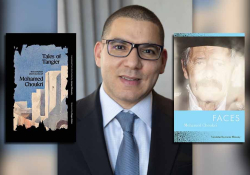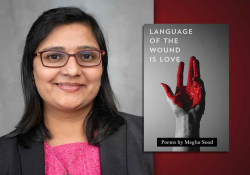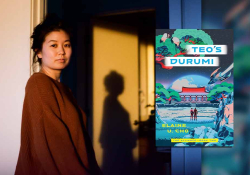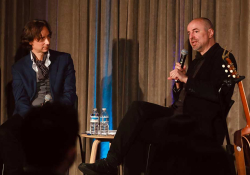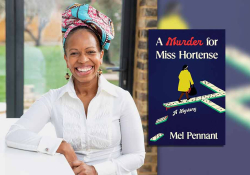Investigating the Icelandic Book Flood: A Q&A with Alda Sigmundsdóttir
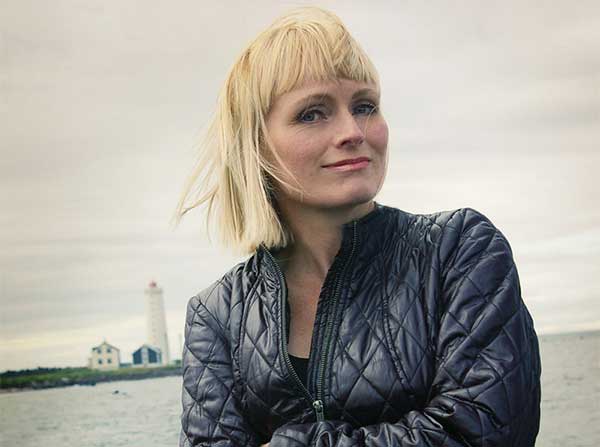
Last Christmas Day, NPR ran a story about the preeminence of the book among Christmas gifts in Iceland. In a country that has the most books per capita in the world, publishers release a majority of these books between September and early November, just in time for the “Christmas Book Flood.” But what of this flood is available in English translation? And why is reading so popular in Iceland? WLT investigates Icelandic lit further with Reykjavík author, translator, and blogger Alda Sigmundsdóttir.
Michelle Johnson: Iceland’s largest publisher has published one of your nonfiction books, the bestseller The Little Book of the Icelanders, and you write regularly for the Guardian. On the other hand, you self-published your first novel and, though you live in Iceland now, grew up abroad, living in Canada, Cyprus, Germany, Spain, and the UK. From this blended perspective, what can you tell us about the publishing culture and reading habits in Iceland, particularly the ways in which these habits are unique?
Alda Sigmundsdóttir: The literary tradition in Iceland is very strong, and intrinsically bound up with the nation’s identity. The Icelandic Sagas were written in the thirteenth century, and in the following centuries Iceland was subject to hardship and humiliation at the hands of its colonial masters. What really helped the Icelanders was that they clung to this memory of the Golden Age when the Sagas were written, and they were still independent. It gave them a sense of national identity and pride, and effectively kept them alive—spiritually, if not physically. At this time, the country was intensely poor, and the population barely managed to survive. All firewood had been stripped from the land, so the people were forced to live in very small turf huts, all huddled together for warmth. Because the winters were so long and dark, the population had to spend many hours indoors, and a tradition developed in the evenings for something called a “kvöldvaka.” This was basically a storytelling session in the communal living area, to keep people awake and entertained while they did their “winter work”—spinning wool, knitting, making tools, and so on. Someone would then read from a book, people would tell stories, or recite epic poetry. Sometimes poetry would be made up on the spot, with someone making up one line, someone else having to contribute the next line, and so on. This is also where the education of children took place. They were taught to read and write, and also learned about history and geography through the telling and re-telling of the Sagas and other stories. It is considered very unique, for example, that even though the nation was so alarmingly poor, almost everyone could read and write. Today there is no illiteracy in Iceland. So the literary and storytelling tradition is a huge part of Iceland’s cultural background and identity, and I think that has been carried through to today.
MJ: On a scale with fighting for survival on one end and thriving on the other, where do Iceland’s bookstores fall? Its libraries? Are they keeping pace with the country’s enthusiasm for books, or are other providers curbing their reach?
AS: My impression is that the bookstores are doing well, though I suppose you’d have to ask someone in the bookselling business to get the full story. I don’t recall any bookstores in Reykjavík closing in recent years, and in fact I there is even a new one that recently opened in my area. Many bookstores now have cafés in them, and they are always packed. As for libraries, they have always done a brisk business in Iceland, and I imagine that has not declined with the financial crisis. Probably quite the opposite. It’s actually interesting to note that the eBook trend hasn’t really taken hold in Iceland, so that whole side of the industry isn’t impacting bookstores in the same way as in, say, the USA.
MJ: Do you have a theory about why reading, writing, and gifting books are so popular in Iceland? As the NPR article notes, though Iceland publishes the highest number of books per capita, Iceland is a small country. Thus, the actual number of books isn’t large compared to, say, the US. Yet the level of engagement is high. Why is that?
AS: I think it has a lot to do with the historical and cultural aspect that I mention above, this relationship between Iceland’s national identity and the literary tradition. And there is genuine interest in and love for the written word in this country. People discuss books a lot, especially during the “Christmas book flood,” when the new books coming out are a ubiquitous conversation topic. People are always asking each other what they think of the new books, what they’re looking forward to reading, and so on—and the discussion takes off from there. The media also does its part, with book reviews, discussions, deliberations about the best and worst book covers, and so on. It gets a lot of space. After Christmas, the same topic is popular around the watercooler, with people talking about what they thought of the book they just read, whether it was better or worse than that author’s last book, etc. This tradition has become very ingrained into the fabric of the nation, just like the tradition of everyone getting at least one book under the tree at Christmas.
MJ: You’ve also written a nonfiction book about Iceland’s 2008 financial crisis, when Iceland went from being one of the wealthiest countries to one of the poorest—in a matter of about two weeks. And you set your novel, Unraveled, against this backdrop. How did Iceland’s financial crisis affect the publishing industry, and are you still seeing the effects even now, five years later?
AS: Amazingly, the financial crisis did not appear to take a toll on the publishing industry. I hasten to add, though, that I’m speaking as an outsider and don’t have any hard figures to back this up. The annual book catalog that gets delivered into all Icelandic homes and effectively launches the Christmas book flood has consistently had a record number of titles in it over the last few years—more titles than before the economic meltdown. In other words, more titles are being published than before the crisis.
MJ: We’ve recently featured financial crisis fiction in our pages. Though it’s an international concern, each country’s experience is, of course, its own. How does Iceland’s financial meltdown work as the background to Unraveled?
AS: Although Iceland’s financial crisis was a part of the global crisis, it was also unique in a number of ways. Iceland was the first country to be hit, and at the time it seemed like it was the only place that would go down, even though many people were saying that it was simply the canary in the coalmine. Also, being such a small country, the impact was very severe. Our three main banks all collapsed within the space of about a week. Our currency became worthless outside of Iceland. We had dreadful corruption surfacing, which no one had suspected was there. It was all so sudden and so shocking. We were all terrified. To compound all that, we had a horrific situation with a bank that had been located in the United Kingdom, but for which Iceland was responsible. It’s a very complicated issue—too complicated to get into here—but Iceland suddenly found itself embroiled in a terrible diplomatic dispute with the UK, with the UK placing Iceland on a list of terrorists along with the likes of Al-Qaeda.
The main protagonist in my book, Frida, is an Icelandic woman who is married to the British ambassador to Iceland. They have recently moved to Iceland when the meltdown happens. I wanted to explore what happens inside such a marriage, when you have two people who love their respective countries, when those countries are involved in such a dreadful dispute. Frida and Damien’s marriage has the same veneer of gloss and respectability as the Icelandic banking sector did prior to the meltdown, but turns out to be built on the same foundation of illusion and lies. As the economy implodes, so does their marriage. Macrocosm–microcosm, if you like.
I’ve always been fascinated by the way people act out their roles in life—the way they pretend—and also the breaking point that inevitably comes when that pretention becomes your life. My protagonist starts off as an acting student . . . her plans don’t come to fruition, but she winds up being an actress in her own life, which is always much more risky because often you don’t know when—or how—to take the mask off. We all have these crisis points in our lives—when we realize we’ve spent our lives acting and we need to discover who we are behind the mask. Usually that results in some kind of private meltdown.
So to get back to your original question, I use the financial crisis both as a backdrop and a catalyst in the story, and also as a symbol for a very human story of love and self-discovery.
MJ: Are readers outside of Iceland able to access much of Icelandic literature? What are the forces at work impacting access?
AS: I think they are. The situation has changed a great deal from what it was a few years ago. People like Arnaldur Indriðason, the crime writer, has done for Icelandic literature what Björk did for Icelandic music—they both put Iceland on the map in their own respective fields. Translations of Icelandic novels are much more common now, and there was a real boom in those after Iceland was the featured country at the Frankfurt Book Fair in 2011.
MJ: Are your books well known to English readers outside of Iceland? How do your books, and others by Icelandic writers, successfully travel abroad?
AS: I think my books are relatively well known to English readers who are interested in Icelandic affairs. I think my social media activities have a lot do to with that. I have some very loyal followers on my blog and on Facebook and Twitter, whom I really treasure. My first nonfiction book, Living Inside the Meltdown, about the impact of the financial crisis on ordinary citizens, was written in response to what many of my blog readers were asking. At the time, there was a lot being written about the big issues concerning the meltdown—the political crisis, the bank crisis and so on—but hardly anything was being said about how these things were impacting ordinary citizens. So I set out to interview a cross-section of people in Icelandic society about their experiences, and released that as an eBook. My second book, The Little Book of the Icelanders, was also published first as an eBook in response to what my blog readers were asking. It was later picked up by a traditional publisher and has sold very well here in Iceland. But I think it’s the kind of book that is localized—it’s something that visitors to Iceland are interested in buying, or that Icelanders buy to send to their friends abroad. I don’t know how well it would fare in, say, a Barnes & Noble. As for Unraveled, it’s still in its early days, so it’s a bit soon to tell how it will fare abroad. We shall see.
As for other authors, I’m not really qualified to answer how their books travel. I just don’t know. Well, except for the aforementioned Arnaldur Indriðason, whose success is well documented (see J. Madison Davis, “Murder in a Cold and Peaceful Place,” WLT, Nov. 2009). Their books are getting out there, though, which is always the first step.
MJ: I’ve noticed AmazonCrossing’s recent focus on translations from Iceland, including one I’m particularly fond of, Audur Ava Olafsdottir’s The Greenhouse. What impact is this having?
AS: I wish I could answer that, but I honestly don’t know. You would have to ask someone who is more involved in the marketing and sales side of things. But on a personal note, I truly applaud Amazon for its AmazonCrossing imprint. Translations of non-English works for the US and UK markets have traditionally been something like 3 percent of the total book publishing market in those countries, and they’ve sold poorly. So for someone like industry behemoth Amazon to make a gesture toward changing this is fantastic. I also think it’s a sign of the times. After all, the world is getting smaller, and fostering a better understanding of each other’s cultures through literature just makes so much sense.
MJ: Who are the Icelandic writers not yet available in English translation you think should be at the top of a need-to-be-translated list?
AS: Another question that’s difficult for me to answer, simply because I have no idea who is being translated, and who isn’t. It seems to me that most of the writers who have been making a splash lately are very quick to pick up foreign book contracts via their publishers. Two that spring to mind are Eiríkur Örn Norðdahl and Kristín Eiríksdóttir. But again, I have no idea whether their books are currently being translated.
MJ: Can you suggest any titles for our readers, whether translated or written in English, that best reflect contemporary Iceland?
AS: Dreamland by Andri Snær Magnason is absolutely essential for understanding the madness that led to the economic meltdown and the insanity of the political parties that brought us there. They are, unfortunately, back in power now. Anything by Arnaldur Indriðason—he writes crime fiction that takes place in contemporary Iceland and gives a good picture of modern Iceland, albeit a rather bleak one. There are also two British writers of crime fiction that have written very good books set in Iceland—Quentin Bates and Michael Ridpath. I’m told that Names for the Sea by Sarah Moss, an English writer, is good, though I haven’t read it.
MJ: What outside of literature has recently captured your attention?
AS: I’m fascinated by the shifting paradigm in publishing these days, and completely obsessed by indie publishing. I love the energy and camaraderie happening in that field, all these writers boldly going forth and doing their own thing, waltzing past the gatekeepers who previously stood in their way, intent on learning from and supporting each other. So much creative energy has been released on a collective scale and there’s such a sense of liberation and joy—it’s great!
On the opposite end of the emotional scale, I’m deeply troubled by the recent political developments in Iceland, and how this new (old) government is brazenly intent on repeating so many of the mistakes that led to the economic meltdown. I am particularly concerned about their environmental policy and their insane plans to sacrifice our beautiful nature to multinational corporations that promise prosperity but in reality exploit and destroy. All for short-term political gain. It is incredibly upsetting.
MJ: What current events or trends in Iceland will serve as background in future Icelandic novels?
AS: I think we’re only beginning to see Icelandic writers working through the trauma of the economic meltdown in their work, and I think the environmental issues will be big in the future, as well. Possibly also the political upheavals and instability. The nation became completely polarized into two political camps in the wake of the meltdown, and it is only getting worse.
MJ: What current projects are you working on?
AS: I have a couple of books in the works, and am also translating a book that was big in the last Christmas book flood. That’s about all I’m prepared to disclose at the moment. I’m one of those people who believes that talking too much about creative projects can jinx them, at least before they’ve taken on a definitive form. I wouldn’t want that to happen.
Alda Sigmundsdóttir is an Icelandic-born writer, journalist, translator, and blogger. She is the author of Unraveled, a novel set against the backdrop of Iceland's economic meltdown, The Little Book of the Icelanders, a humorous take on the quirks and foibles of the Icelandic people, and Living Inside the Meltdown, about the effects of Iceland’s financial crash on ordinary citizens. English is her first language, and she has written extensively about Iceland for the international media. Her translations from Icelandic to English are diverse and numerous, ranging from advertising copy to published fiction and nonfiction. Sigmundsdóttir blogs at icelandweatherreport.com and on her website, aldasigmunds.com.
Several Recent Translations
On the Cold Coasts by Vilborg Davíðsdóttir, tr. Alda Sigmundsdóttir
“House No. 451” by Gyrðir Elíasson, tr. Victoria Cribb
House of Evidence by Viktor Arnar Ingólfsson, tr. Björg Árnadóttir & Andrew Cauthery
Gunnloth’s Tale by Svava Jakobsdóttir, tr. Oliver Watts
LoveStar by Andri Snær Magnason, tr. Victoria Cribb (reviewed in the July 2013 issue of WLT, page 60)
The Greenhouse by Auður Ava Ólafsdóttir, tr. Brian FitzGibbon
The Day is Dark by Yrsa Sigurðardóttir, tr. Philip Roughton
From the Mouth of the Whale by Sjón, tr. Victoria Cribb
Word Without Borders’ October 2011 issue, Writing from Iceland
